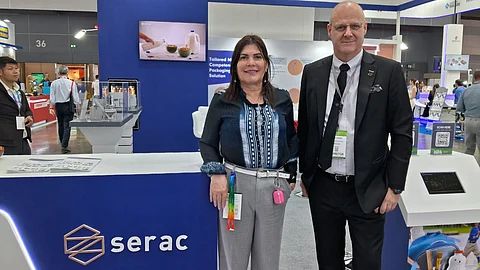
- Home
- EventsEvents
- Product Launches
- CategoriesCategories
- Advertise
- Opinion

As ProPak Asia 2025 concluded this past week, the bustling exhibition halls of BITEC Bangkok buzzed with innovations across food processing, packaging, and automation. Among the standout participants was Serac, a global leader in packaging and filling solutions, which used the event to highlight its Asia-Pacific strategy and its advanced packaging technologies.
In an exclusive interview, Paul Heskens, Managing Director of Serac Asia, provided deep insights into the company’s regional focus, global integration, and future innovation roadmap. With a spotlight on innovation, regional manufacturing, and customized solutions, Serac reinforced its commitment to addressing the evolving needs of the food, dairy, and non-food industries across Asia.
A global brand with a local soul
“Serac is quite unique in our industry because of our decentralized footprint,” Heskens began. “We have manufacturing facilities on multiple continents—Chicago, São Paulo, three in France, and our Asia-Pacific base in Malaysia.”
This geographical distribution is more than just a logistical strategy. Heskens recalled the lessons learned during the COVID-19 pandemic: “When borders were closed and travel was restricted, being close to our customers became invaluable. Unlike some centralized competitors struggled to reach out, we could still respond quickly thanks to our regional presence.”
He emphasized how this decentralized model helped Serac evolve into a more resilient and adaptive organization, especially in times of global disruption.
Centers of Excellence: Tailoring expertise to regional needs
To further this strategic adaptability, Serac has established Centers of Excellence based on regional demands. “In Asia, we are the go-to team for sauces and edible oils,” Heskens shared. “It makes sense—Asia is arguably the biggest kitchen in the world.”
Serac's global model is highly collaborative and cross-functional. While Asia specializes in food categories like sauces and oils, teams in other regions contribute deep expertise in additional segments such as dairy, home and personal care, and agrochemicals. “We also have strong capabilities in supplying cup filling & non-food packaging solutions across markets,” Heskens noted.
Tackling industry shifts: Meeting demands for extended shelf life
Serac is closely tracking evolving market demands across categories. “In dairy, the challenge is shelf-life extension,” said Heskens. “Many producers are aiming for ambient shelf life to better manage supply chains, but transitioning from ESL (Extended Shelf Life) to full aseptic is a major step.”
Recognizing this, Serac is responding to a growing trend in Asia by simplifying aseptic packaging solutions. “Customers are looking for a middle ground—something that offers higher hygiene and longer shelf life without the full cost and complexity of aseptic. That’s where our solutions are focused,” Heskens noted.
A similar shift is happening in the sauce segment. “As consumers demand products with less salt, sugar, and additives, hygiene and shelf life become even more critical,” he added. “While sauces may not require full aseptic conditions, ultra-clean environments and optimized bottling are becoming essential.”
ProPak Asia 2025: A platform for connection and growth
At this year’s ProPak Asia, Serac showcased its Combi-Boxes—compact, flexible systems that integrate blow molding and filling capabilities.
“These systems cater to high-output needs without taking up much space. You can run bottles from 250ml to 1.5L using the same setup,” Heskens noted. “Thailand, being a major sauce producer and exporter, is the ideal market for such solutions.”
The company’s exhibit reflects insights gained from a comprehensive market study launched two years ago. “We chose to concentrate on edible oils, sauces, and dairy. You can't be everything to everyone,” Heskens said.
Serac’s growth strategy is sharply focused on selected sectors. “After a deep market study two years ago, we chose to concentrate on edible oils, sauces, and dairy in Asia-Pacific. While in India, sauce isn’t a major category due to traditional cooking, edible oils and agrochemicals are important.”
He added, “We see good momentum in Vietnam, renewed energy in China, and steady performance in Thailand. Malaysia is slower but remains key—it’s our home base.”
Strategic innovation in Southeast Asia
“We want our Malaysian facility to be capable of producing our entire solution range, including aseptic lines,” Heskens revealed. “Right now, we still depend on France for aseptic production. Bringing that expertise to Asia will drastically cut lead times and improve service.”
This regional empowerment is core to Serac’s three-to-five-year vision: offer more ultra-clean and localized solutions while maintaining global standards.
Customer-centric engineering: Serac’s differentiator
Asked what message he’d like to share with customers, Heskens was unequivocal: “We are not afraid of challenges. Many in this industry stick to catalog products. We are different—highly customer-oriented, sometimes to our own pain.”
Serac embraces customization when customers are equally invested. “If a project needs extra engineering time to meet unique specifications, we are open to it. That collaboration is what sets us apart,” he added.
This philosophy of co-innovation has allowed Serac to remain agile and relevant in an industry that constantly evolves.
Serac’s presence at ProPak Asia 2025 was more than a return to a major industry event—it was a reaffirmation of its commitment to the Asia-Pacific region. By combining global expertise with local manufacturing and market-specific solutions, the company continues to demonstrate that its real strength lies not just in engineering—but in listening.
He concluded with a clear message: “Our mission is to give customers exactly what they need to succeed. Our global network, regional focus, and flexibility make Serac a true partner—not just a supplier.”
Click HERE to subscribe to our FREE Weekly Newsletter
